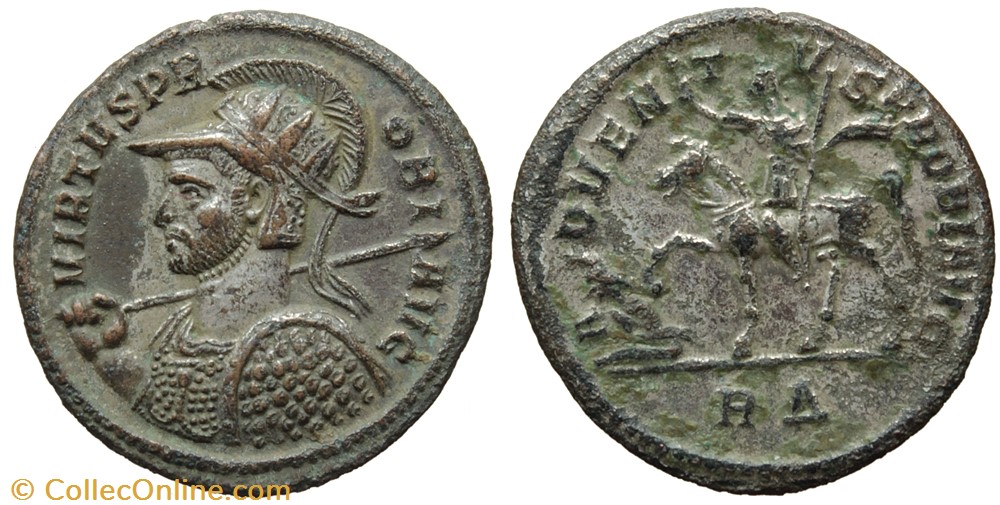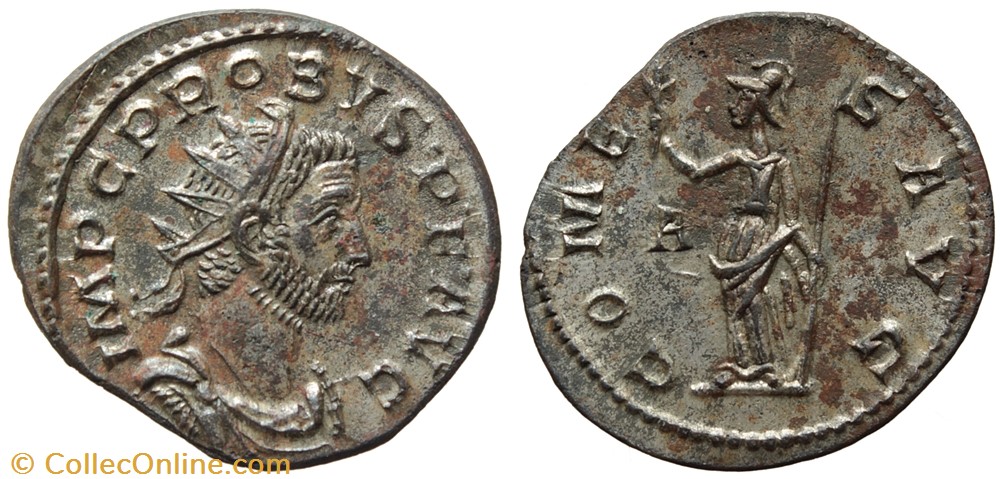-
Posts
12 -
Joined
-
Last visited
Content Type
Profiles
Forums
The Numis Journal
Events
Downloads
Gallery
Store
Classifieds
Posts posted by Ronalovich
-
-
11 minutes ago, GordianAppreciator101 said:
Love it! Siscia has to be my favorite mint for Probus' consular busts; a topic that I hope to discuss in depth one day.

Roman Empire, Probus AE Antoninianus. Third Officina of Siscia, Fourth Emission (277 AD). RIC Vb Probus 820.
Obverse: IMP C M AVR PROBVS PF AVG. Radiate bust left, wearing the consular robes and holding and eagle-tipped scepter.
Reverse: VIRTVS PROBI AVG. Two captives at base of trophy. XXIT in exergue.
Probus Coins (Online) 2591 (This coin cited)
-
 8
8
-
-
Probus' coinage is known for its wealth of diversity concerning how Probus depicted himself through his bust types. While Probus introduced many bust types and countless variations, I want to focus on two of my favorite Probus coins from my collection: a standard military bust and a very special variation.
The Military Bust:
As nearly all the emperors of the Third Century hailed from the army, the portraiture on the coinage also became increasingly militaristic. The standard depiction of the emperor in the earlier empire was usually just his head with the appropriate headwear (i.e. a portrait showing the emperor's head and neck along with a laurel wreath), but during the Third Century, nearly all of the busts included at least a military cuirass. The military bust brings the martial progression of the emperor's depiction to its end as it shows the emperor completely as a soldier with full armor, a helmet, and weapons. Earlier emperors struck militaristic busts with slight variations, but Probus was the first to mint these portraits in regular numbers.

Roman Empire, Probus AE Antoninianus. Fourth Officina of Rome, Second Emission (277 AD). RIC Vb Probus 166
Obverse: VIRTVS PROBI AVG. Radiate, cuirassed, and helmeted bust left, holding spear and shield.
Reverse: ADVENTVS PROBI AVG. Emperor on horseback left, right hand raised, holding scepter in left, captive below. RΔ in exergue.
The Parma Bust:


Roman Empire, Probus AE Antoninianus. Second Officina of Siscia, Seventh Emission (280 AD). Ric Vb Probus 648 (unlisted var.)
Obverse: IMP C PROBVS P AVG. Radiate, cuirassed, and helmeted bust left, holding spear and parma.
Reverse: CLEMENTIA TEMP. Probus standing right, holding scepter and receiving globe from Jupiter, standing left, holding scepter. Crescent in bottom field, KA in exergue.
This coin deviates strangely from standard Probus coinage in several ways. Only four examples of this type are known to me; one is in the collection of Barnaba Skibniewski, and two others (including the example cited in Alfoldi), which are in a private UK collection. The fourth example is this one.
Firstly, the obverse legend of this coin is quite strange. Pius Felix, abbreviated to PF, was a very common title on the coinage of Roman emperors, but here it is just written as Pius (IMP C PROBVS P AVG). Siscia struck four different obverse legend variations with the P-only titulature, and while these legends span several different reverse types, nearly all of the individual types are rare.
What distinguishes this bust from a standard Probus military bust is the type of shield that the emperor is holding. Virtually all of Probus’ military busts depict him with an ovaloid shield, as it is this type of shield that replaced the iconic rectangular scutum during the Third Century, but here Probus wields a parma instead. The parma, a smaller and rounder shield, was originally used by velites — very light and low-ranking troops. With the military reform of Emperor Gallienus two decades earlier, much more emphasis was placed on mobile cavalry units in order to face the threats of the Third Century. Cavalrymen generally preferred smaller shields like the parma, as they were much lighter and wieldier on horseback. While Probus was not a cavalryman himself, he may have been either nodding to the cavalry, or reinforcing his Roman nobilitas, as horsemanship was always associated with nobility. Parma variations are rare at the mints of Siscia and Serdica, and they are extremely rare at Cyzicus and Ticinum.
Finally, while CLEMENTIA TEMP is an incredibly common reverse for Probus, to see it in conjunction with the mint of Siscia and the mintmark of KA is highly peculiar. Several mints struck this reverse, but Siscia only struck a few types (RIC Vb 641-648) with CLEMENTIA TEMP. Of these eight scarce types, about half use the XXI mintmark, while the other half use KA. Siscia was decidedly a western mint, and it only used the KA mark with a handful of reverse types, compared to the hundreds that used the correct mark of XXI. This coin also has an eagle-less sceptre on the reverse, which likely precludes the possibility that the reverse die came from another mint, as I could find no examples of a CLEMENTIA TEMP reverse with both an eagle-less sceptre and the KA mintmark from elsewhere. One possible explanation for this anomalous mintmark is that an eastern engraver somehow arrived at Siscia and carved the design with the wrong mintmark, but without good evidence, this is just conjecture.
You can see this coin along with some others featured in the Classical Numismatics video Ancient Coins: The Restorers of the World
Post any of your Probus coins or special variations on a regular coin!
-
 14
14
-
 3
3
-
 2
2
-
-
2 hours ago, DANTE said:
Instead of watching TV this morning, I quietly whittled away on this one, inspired by @Helvius Pertinax and @Ronalovich's fantastic avatars. The original picture I used isn't really high-res, so it get's a bit blurry and granulated when you zoom in. Tracing the reverse was a labor of love (but also strangely therapeutic and calming). Also, it was surprisingly interesting, tracing every line and every detail the die-cutter has made in the die really makes you appreciate their handywork and incredible skill in a whole new way!). Overall, I'm quite pleased with the result.
'Reduced' follis:
Constantine II, Cyzikus, with some smoothing of the fields.
Awesome work! You can also put these images onto a textured background of roughly the same color, like in my pfp. I find these types of cropped coin photos to be very striking.
-
 3
3
-
-


Here's another city commemorative- mandatory for Roman coin collectors.
-
 10
10
-
-
2 minutes ago, TheTrachyEnjoyer said:
Seems impossible. You cant strike a scyphate coin with flat dies or vice versa. As the US collectors would say, this is “PMD”
Thanks for the correction! You definitely are a scyphate coin enjoyer.
-
 1
1
-
 1
1
-
-
6 minutes ago, Furryfrog02 said:
Why? Was it mistruck?
Definitely, it must have been some bizarre minting error.
-
 1
1
-
-
Here's a bizarre Aurelian trachy. It looks like you can see the remnants of the reverse's bead border, but I can't even start to identify what the reverse was.

-
 13
13
-
 1
1
-
 1
1
-
-
-
 21
21
-
-
The unknown eastern mint Probi are pretty fascinating. Some members here have already mentioned the possible connection to Saturninus.
RIC typically attributes the unknown eastern mint coins to Antioch, so the best way to distinguish them is
A). Poor style on the bust
B). Font on the M
Antioch usually formed the M poorly, with the lines not really being connected (it looked something like |V|)
The unknown eastern mint formed the M much better, with the letter actually being connected. Here are Antioch and the unknown mint respectively for comparison.


-
 5
5
-
-
Mine is from a consular Probus of mine.
I saw some pictures with the portrait of a coin cropped out and placed on a textured background, and I loved how they looked, so I decided to do it myself.


-
 25
25
-
-
I just picked up this Probus from Lugdunum.

Probus RIC Vb 116
IMP C PROBVS •P•F• AVG. Radiate and draped bust right, seen from the front.
COMES AVG. Minerva standing left, holding olive branch and spear, resting hand on shield. A in left field.
I primarily collect Probus because I love the wealth of diversity in his bust types, so I'm excited to pick this one up, as it's my first draped bust seen from the front. Probus' draped busts are usually seen from the back. The portrait caught my eye on this coin.
-
 23
23
-























Probus and the Roman Cavalry: A Special Bust Variation
in Roman Empire
Posted
Very nice! And also a part of the AEQVITI series of Ticinum!